Symptoms of Depression: How to Tell if It’s More Than Just Sadness
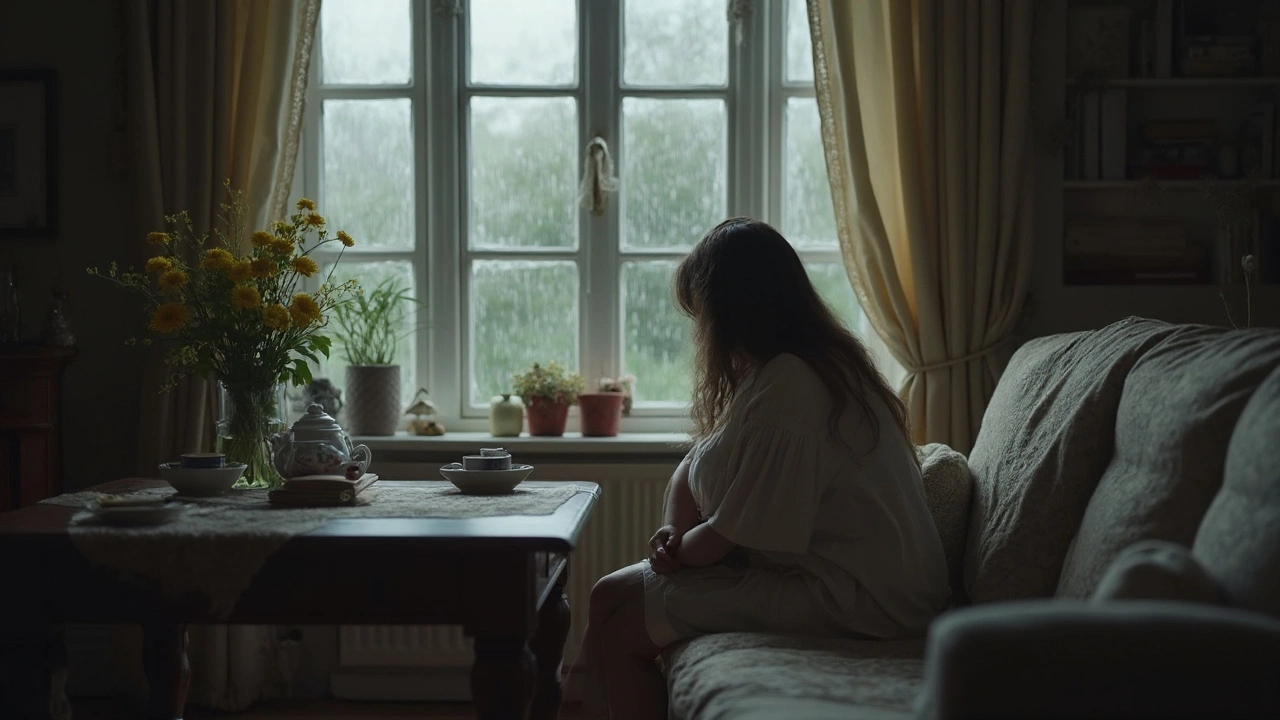
Ever had one of those days where everything feels heavy, but then the next day, you’re sort of back to your old self? That’s sadness—a normal, human feeling. Now, depression? That’s a whole different animal. It sticks around even when things should feel okay, making it hard to get up, care about stuff, or even enjoy what you used to love.
Telling the difference isn’t always easy, especially with how much people toss around the word “depressed” when they’re just having a rough week. Here’s the thing: real depression shows up in ways that sadness never will. If you start losing interest in things that once mattered, can’t shake the gloom for weeks, or notice your sleep and appetite are off, those aren’t signs to ignore. Spotting these things early matters, for you or for anyone close to you.
You’re not alone if you’re wondering where the line is. My own kids, Avery and Reed, have asked about it after a rough school year, and I’ve seen firsthand how easy it is to brush off the signs because nobody wants to believe something bigger is going on. The truth? The sooner you can spot what’s really happening, the better chance you have at feeling like yourself again. Keep reading—these next sections break it down into simple, clear signs to look out for.
- Sadness Versus Depression: The Big Difference
- Spotting Core Signs of Depression
- Everyday Sadness: Why It Happens and How It Shows Up
- Red Flags: When to Take Action
- Helping Yourself or Someone Else
Sadness Versus Depression: The Big Difference
Everybody feels sad sometimes. Maybe you got bad news at work, lost a pet, or just had a lousy argument with a friend. Sadness is like an emotional bruise—it hurts, but it usually fades with time, support, or a good distraction. Sadness tends to be tied to something specific, and it comes and goes. You cry, maybe vent to a friend, and slowly, things look up again.
Depression isn’t tied to one event. It’s not just about feeling sad—it can feel like a dark cloud that follows you everywhere, for weeks or months, whether or not anything “bad” happened. And it doesn’t always have a clear cause. The sadness with depression just doesn’t lift, even when good things happen or you try your usual ways to cheer up. It can drain your energy, mess with your sleep, and make you lose interest in just about everything—even activities you used to love.
So how can you tell what’s what? Here are the big differences:
- Duration: Sadness fades with time. Depression sticks around two weeks or longer and often gets worse if ignored.
- Impact: Sadness might bum you out, but it doesn’t stop you from handling life. Depression can make it tough to get out of bed, focus, eat, or care about work and family.
- Cause: Sadness usually has a reason. Depression might show up out of nowhere or feel out of proportion to what’s happening.
- Physical Symptoms: With depression, your body often reacts—think headaches, changes in appetite, trouble sleeping, or weird aches and pains.
- Feelings about Yourself: Sadness doesn’t usually make you feel worthless. Depression often drags your self-esteem down, making you feel hopeless or full of guilt.
Take a look at this simple breakdown:
| Sadness | Depression | |
|---|---|---|
| Length | A few days | 2+ weeks |
| Reason | Clear event or cause | Sometimes unclear or no reason |
| Everyday Function | Can manage daily stuff | Daily life feels too hard |
| Physical Changes | Rare | Common (sleep, appetite, aches) |
If you notice these symptoms of depression lasting and making daily life tough, it's time to look closer. It’s not just having a rough week—it’s a health problem, like catching a bad cold that doesn’t go away on its own. Spotting the difference is crucial for you, your friends, and your family.
Spotting Core Signs of Depression
If you’re wondering if it’s more than just a blue day, you need to look at what makes depression stand out. It isn’t only about feeling sad—plenty of people with depression don’t feel sad every day. The symptoms reach deeper and stick around for weeks, not just days.
The American Psychiatric Association lists some core symptoms that doctors look for. If you recognize a few of these lasting most days, almost every day, for at least two weeks, it’s time to take things seriously:
- Persistent low mood or irritability: You can’t shake the rough feeling. Some people, especially teens, show it as anger or irritability instead of plain sadness.
- Loss of interest or joy: Stuff that once lit you up—sports, music, hanging out with friends—suddenly seems dull or pointless.
- Big changes in appetite or weight: Either you’re barely eating or you can’t stop snacking. There may be clear weight loss or gain with no other reason.
- Sleep problems: Trouble falling asleep, staying asleep, or even getting out of bed. Some folks need way more sleep than before, some can’t sleep at all.
- Low energy: Just making it through a normal day feels like a marathon. Even small tasks are draining.
- Feeling worthless or guilty: You start blaming yourself for stuff that isn’t your fault, or feel like you don’t matter.
- Struggle focusing: You can’t keep your mind on school, work, or even a simple conversation. Decisions (even little ones) become tough.
- Thoughts of self-harm or suicide: These are urgent red flags. If these come up, reach out for help right away, no excuses.
For an idea how common these core symptoms of depression are, check out this quick look at survey data from the National Institute of Mental Health:
| Symptom | Estimated Percent Affected (U.S. adults, past year) |
|---|---|
| Low mood / Loss of interest | 100% |
| Sleep changes | 90% |
| Low energy | 85% |
| Difficulty focusing | 70% |
| Significant appetite changes | 65% |
| Suicidal thoughts | 35% |
Depression symptoms can also look different for different people. Kids might get moody or act out, adults might just feel numb or overwhelmed. If you check the boxes for several of these symptoms, and it’s been two weeks or more, you’re looking at something more than a rough patch. Don’t wait to see if it blows over—talk to a doctor, a counselor, or someone you trust. Catching depression early makes getting help so much easier.

Everyday Sadness: Why It Happens and How It Shows Up
Everybody feels sad sometimes—even if you don’t like admitting it. Everyday sadness pops up for all sorts of reasons. Maybe you argued with your partner, didn’t get the job you wanted, or just hit a rough patch out of nowhere. This is your brain’s way of processing disappointment, stress, or even big changes, and it’s completely normal.
The key thing about regular sadness is it’s short-term. It usually gets triggered by specific stuff. Think about when Avery lost a soccer game—she was bummed for a day, but then got excited for the next practice. The feeling doesn’t stick around, and it doesn’t take over other parts of your life. You still sleep pretty much the same, eat what you usually eat, and can laugh at a dumb joke. Your work, hobbies, and relationships might feel heavier for a while, but they don’t completely fall apart.
Here are some common ways sadness shows up:
- You cry more than usual over things that matter to you.
- Your energy or motivation dips, but you snap back after some rest or good news.
- Feelings of frustration or disappointment about one specific event.
- You want comfort from friends, family, or even your favorite TV show.
Fact is, about 80% of adults say they feel what they’d describe as strong sadness a few times each year. Unlike depression, sad moods usually start to lift when life’s stress eases or the problem gets solved. Most people don’t lose interest in everything—they just feel stuck temporarily.
There’s no need to freak out over feeling blue for a little while. Life’s ups and downs are part of being human. As long as the feeling doesn’t drag on and turn your world upside-down, it’s probably just everyday sadness.
Red Flags: When to Take Action
Knowing the difference between a bad mood and depression could save a life. Some signs go beyond feeling sad and scream, “Hey, you need help!” If these show up, you shouldn’t just tough it out or wait for things to magically get better.
Here’s what you really need to watch for:
- Feeling hopeless almost every day for more than two weeks.
- Not caring about stuff you usually love—even your favorite foods or hobbies.
- Changes in sleep: either barely sleeping at all or wanting to stay in bed all day.
- Big changes in appetite and weight (up or down—either way is a warning).
- Having zero energy or always feeling tired, no matter how much you rest.
- Trouble focusing, making decisions, or remembering things that should be simple.
- Feeling like life isn’t worth it or thinking about hurting yourself. This is the biggest warning sign and means you need to reach out for help immediately.
The American Psychiatric Association puts it plainly:
"Depression is more than just sadness; it can take over how you think, feel, and function. If it sticks around and stops you from living your life, that’s when it’s time to get support."
Most doctors use a standard checklist to spot symptoms of depression. The first step? Look for a pattern that lingers at least two weeks. If it keeps you from getting out of bed or wrecks your relationships, don’t ignore it.
Check out some quick facts (these numbers come from mental health research published in 2023):
| Red Flag | % of Patients With Depression |
|---|---|
| Loss of interest in normal activities | 76% |
| Persistent sad or empty mood | 88% |
| Ongoing tiredness/loss of energy | 80% |
| Appetite or sleep changes | 65% |
If you spot these red flags in yourself or someone you care about, don’t keep quiet. Talk to a doctor, text a crisis hotline, or let someone close to you know what’s going on. Waiting and hoping things get better rarely works with mental health stuff like this.
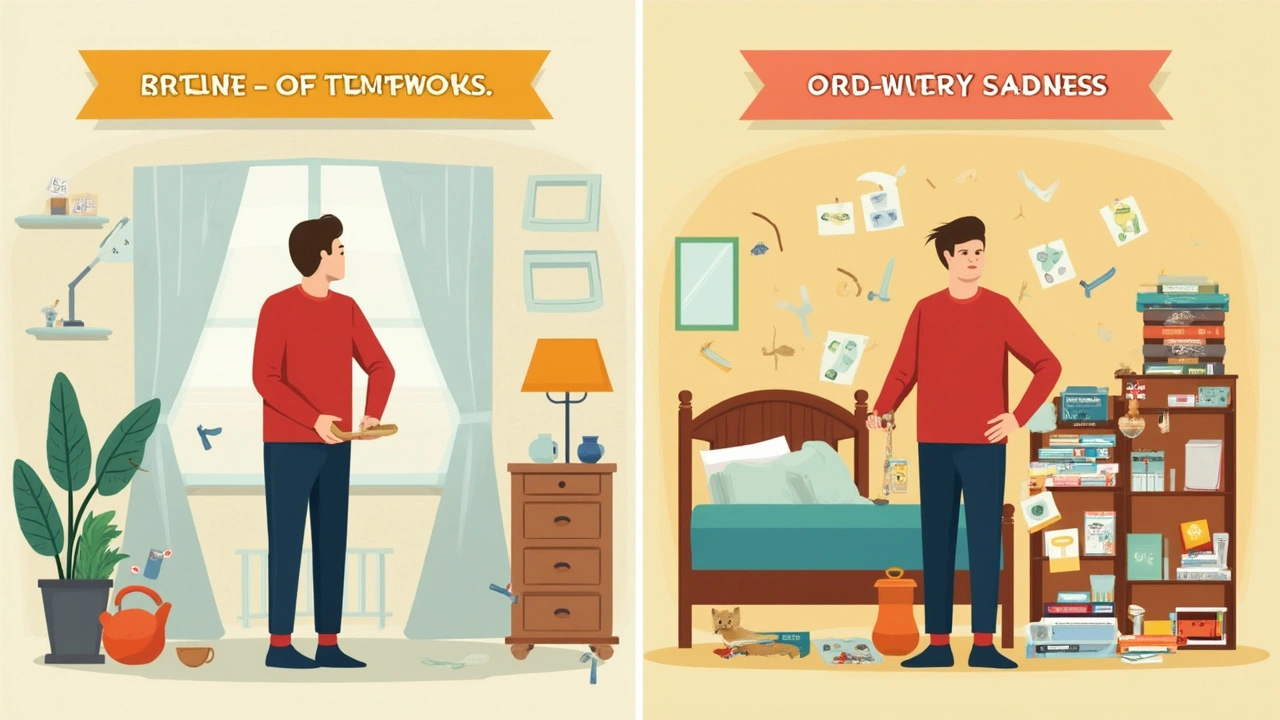
Helping Yourself or Someone Else
When it comes to depression or deep sadness, getting help early makes things way easier in the long run. You don’t have to figure it all out on your own, though knowing what to actually do helps big time. Here’s the stuff that really matters if you or someone close might be dealing with symptoms of depression.
First, track what you’re feeling. No one needs a fancy journal. Just pay attention to changes in sleep, eating, or the things you care about. If you notice these changes for more than two weeks, that’s a classic warning sign.
Talking to someone is the next big step. Doesn’t need to be an expert right out of the gate—just a friend, family member, or anyone you trust. More folks than you think have been in the same boat, and talking can take a load off. If you’re ready for more support, reaching out to a mental health professional is the best move.
- Make a doctor’s appointment: Even your regular family doc can screen for depression and steer you where you need to go.
- If it’s someone you care about, don’t try to “cheer them up.” Instead, let them talk, listen, and let them know you’re there.
- Help with small things: Offer a ride, send a text, or invite them for a walk. Little acts matter more than any grand speech.
- If you or they mention not wanting to live—or things get scary—skip all the advice and call or text a local crisis hotline. In the U.S., it’s 988 for the Suicide & Crisis Lifeline.
Depression doesn’t care about age, job, or background. About 1 in 5 people will deal with it at some point, so it’s more common than most people think.
| Support Options | What They Offer |
|---|---|
| Therapist/Psychologist | Talk therapy, coping tools |
| Primary Doctor | Initial checkup, referrals, sometimes medication |
| Hotlines | Immediate support, safety planning |
| Friends/Family | Emotional backup, company, practical help |
And don’t forget: self-care isn’t selfish. Eating regularly, sleeping enough, and even a walk outside can take the edge off those tough days. Apps, podcasts, and online forums also give you a way to connect if talking face-to-face is tough at first.
Last thing—don’t try to “tough it out.” Spotting symptoms of depression means it’s time to treat yourself with the same care you’d give your best friend. Whether it’s for you or someone close, these steps open the door to feeling better, one small action at a time.


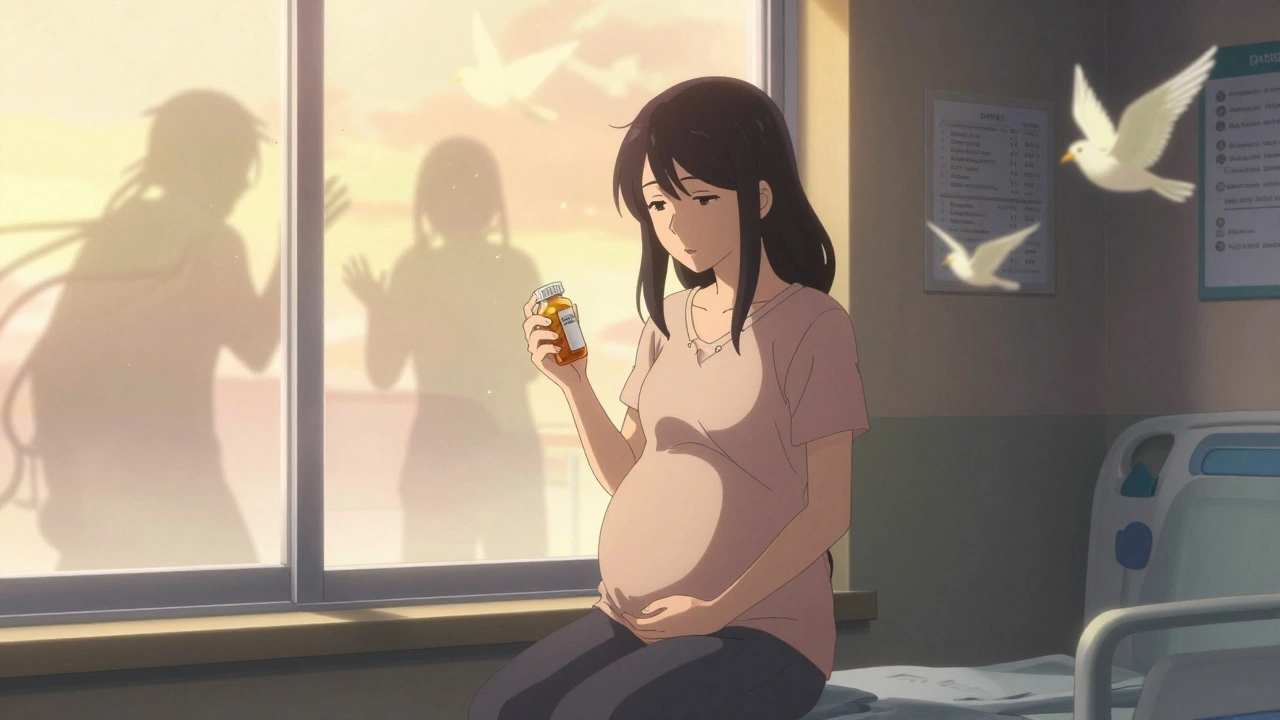
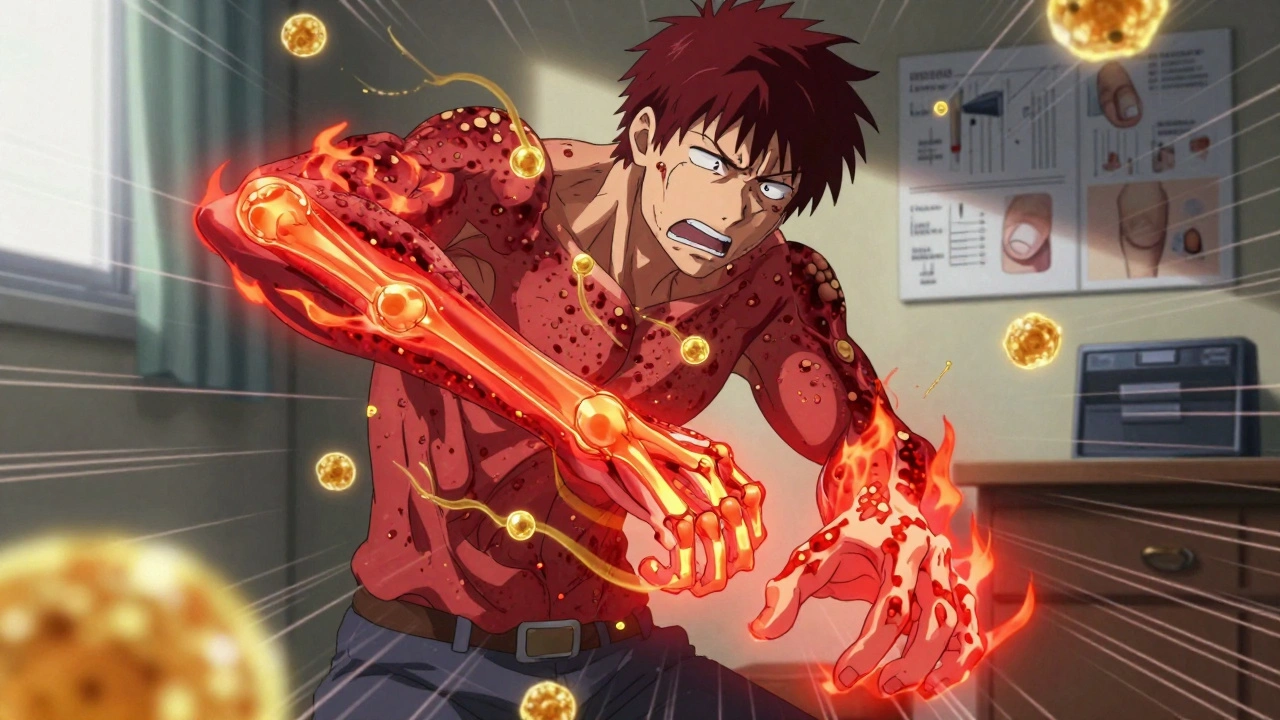
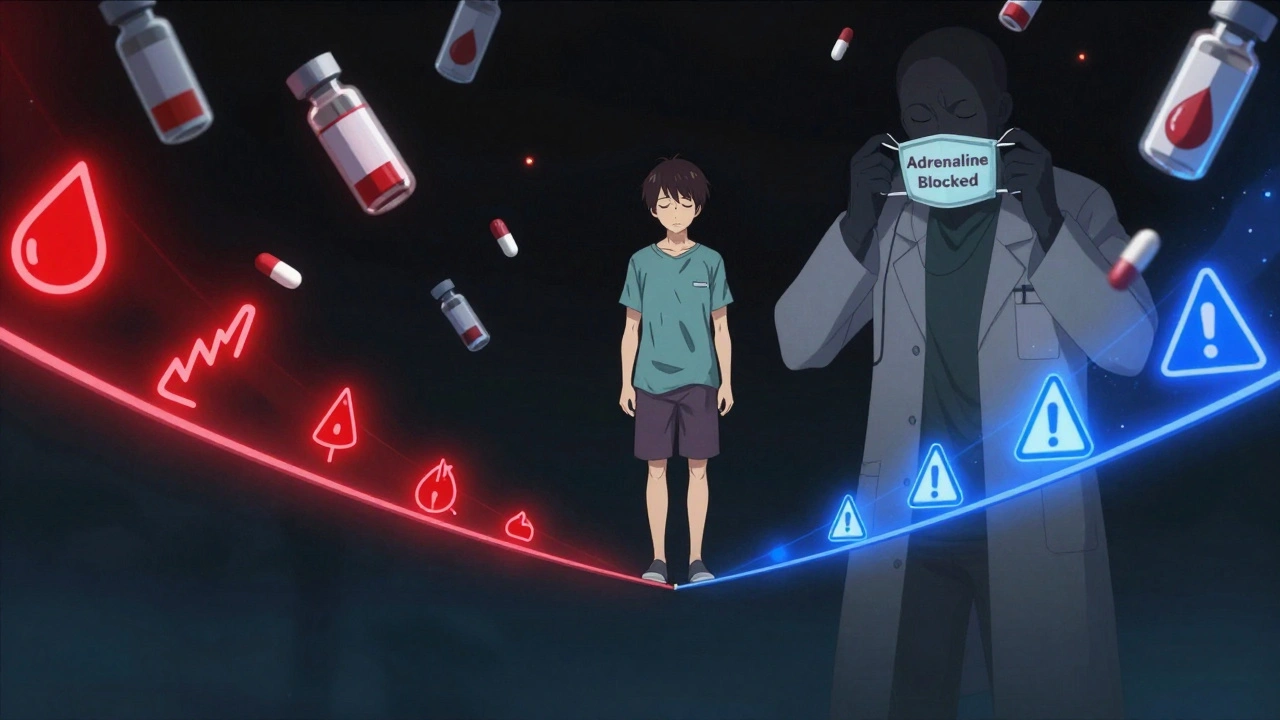
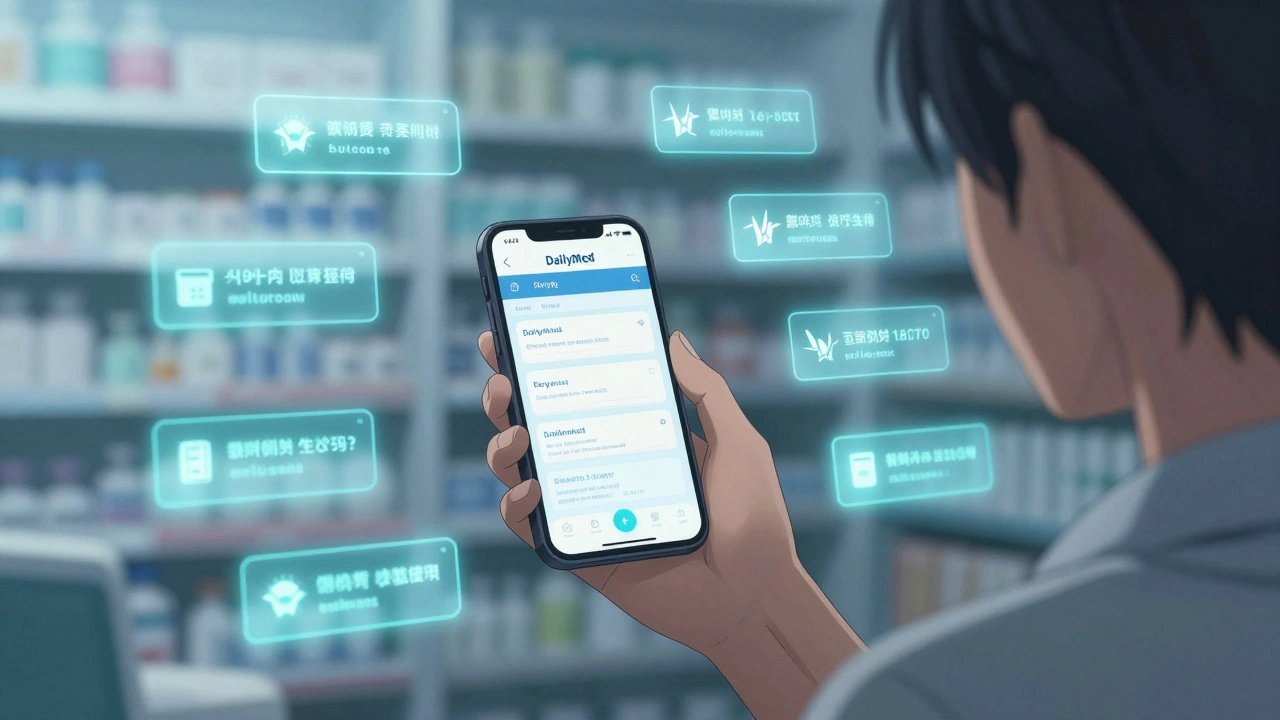
Comments
nalina Rajkumar
July 18, 2025 AT 07:58This article hits home in so many ways 😊. Sometimes people think sadness and depression are the same but that distinction matters a lot for getting help. I love how the article lays out clear examples instead of clouding things with too much medical jargon.
Also, those simple tips on noticing symptoms early on are gold ✨. It makes it less scary to approach the topic, which is often ignored due to stigma. Having something easy to understand encourages folks to check in on themselves and those around them.
Has anyone here shared this with someone who later realized they needed more support? I'd love to hear if the advice translated well in real life contexts.
Michael Barrett
July 22, 2025 AT 09:31Indeed, the essential differentiation between transient emotional states and clinical depression cannot be overstated!!! Too many people mislabel their feelings merely as sadness without recognizing the underlying chronicity and depth of depression.
But the philosophical question remains: is sadness a subset of depression or simply a human condition unto itself??? This article provides pragmatic clarity which is vital because many academic discourses fall short in translation.
Furthermore, the emphasis on early recognition has enormous implications for public health policies worldwide!!! Prevention begins with awareness, and that awareness begins with education such as this.
Gavin Potenza
July 27, 2025 AT 01:46You know, sometimes I find the way we interpret our inner emotions to be so culturally influenced and complex. This piece makes a strong attempt to universalize the symptoms of depression, which can be quite challenging given how sadness and depression manifest differently depending on social context.
But I do appreciate the article’s focus on providing relatable examples — that’s crucial to engagement.
Does anyone else feel like sometimes depression is dismissed as ‘just a phase,’ and this article helps articulate why that’s a harmful misconception?
Virat Mishra
July 31, 2025 AT 18:16Honestly, I feel like all this depression talk is overdone lately. Everyone thinks they’re depressed just 'cause they’re sad for a day or two.
This article might be useful, but come on, real depression is something else entirely and way more intense than what most people say.
Some folks just wanna complain. Still, I guess if this helps them sort out what's real, it’s not all bad.
But seriously, can we stop calling every bad mood depression? It dilutes the meaning.
Daisy Aguirre
August 3, 2025 AT 20:08Thank you for bringing this up so thoughtfully. It’s so important to understand the difference because it empowers people to seek the right kind of help without feeling ashamed or confused.
I also appreciate how it encourages recognizing early symptoms because catching depression early really can change outcomes dramatically.
And reminding everyone that it’s okay not to be okay at times but that persistent feelings shouldn’t be ignored, is such a gentle but powerful message.
Hope more people get the chance to read this and feel less alone.
Natalie Kelly
August 7, 2025 AT 10:43This article is a solid resource! Sometimes people don't know when to reach out or even admit to themselves something feels off.
Having clear signs helps break down the barrier of denial for many. I often see folks dismiss their symptoms because they 'aren't bad enough.'
What do you all think about the practicality of these tips? Could they be applied in everyday conversations with friends or family?
Tiffany Clarke
August 9, 2025 AT 20:40Ugh, sometimes it feels like no one really cares to understand the depth of what depression feels like. Articles like this try but often fall short for me.
People throw around 'sadness' and 'depression' like they’re interchangeable and it’s exhausting.
Still, I get the point here and appreciate the effort to clarify.
Not everyone has the energy to dig deep and seek real help, so simple info is vital.
Sandy Gold
August 11, 2025 AT 11:13Frankly, the distinctions made in this article are rudimentary at best. The conceptual framework of depression exceeds simple symptom checklists and requires nuanced understanding.
However, given the general audience, this presents accessible knowledge which might challenge widespread misconceptions.
One could argue this oversimplification diminishes the complexity of mental health but it likely serves as a necessary starting point for many.
What’s most important is that people stop hiding behind vague terminology and confront their issues directly.
Frank Pennetti
August 13, 2025 AT 18:46This whole conversation gets tiring. So-called depression is way overdiagnosed and often used as an excuse for weakness, especially in our culture.
If you can't handle some sadness or loss, that's life. These articles make people soft with all this talk about early symptoms and therapy.
Grow up, stand up, and face reality instead of wallowing. Period.
Adam Baxter
August 15, 2025 AT 12:26I think it’s crucial to call out that depression isn’t just feeling down. Sometimes a little awareness goes a long way to avoiding deeper struggles.
Everyone should learn this stuff early, like in schools or just casual talks.
If we can remove stigma by normalizing the fact that depression is an illness and not a character flaw, we could save so many people pain.
Plus, practical tips make a complex topic less overwhelming.
Keri Henderson
August 16, 2025 AT 16:13I totally agree with the approach this article takes. Being assertive but compassionate when noticing signs of depression in yourself or others can be a game changer.
Too often people shy away from these conversations due to fear or stigma, but equip yourself with knowledge as this article encourages, it makes those discussions easier.
Also, I love the balance between giving real examples and simple tips — it's empowering rather than overwhelming.
This kind of open dialogue is exactly what we need more of.